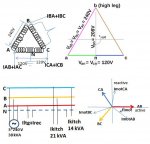ghpham288
Member
- Location
- california
Hi All. I'm new to the forum here. I'm studying electrical engineering and having a hard time understanding the 120/240V high leg delta calculations and hoping the senior members here can help. I have the following loads below:
240 3 phase motor loads total = 38 kva
240 1 phase kitchen loads total = 21 kva
120 1 phase lighting loads total = 9 kva
120 1 phase kitchen loads total = 14 kva
120 1 phase general receptacle loads total = 9 kva
B is the stinger leg.
I've calculated the maximum feeder load to be 194 amps applying 1.25% for lighting continuous loads, and 65% for the kitchen load. Not sure if I did this correctly? Can a member please help?
240 3 phase motor loads total = 38 kva
240 1 phase kitchen loads total = 21 kva
120 1 phase lighting loads total = 9 kva
120 1 phase kitchen loads total = 14 kva
120 1 phase general receptacle loads total = 9 kva
B is the stinger leg.
I've calculated the maximum feeder load to be 194 amps applying 1.25% for lighting continuous loads, and 65% for the kitchen load. Not sure if I did this correctly? Can a member please help?






